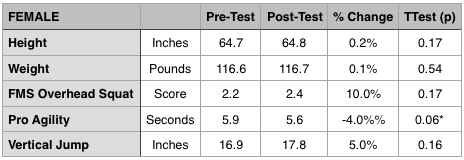
Samuel McCue, USAW SPC-L1, CF-L1
Adam Scott, MS, CSCS
Background
Whether an athlete is a high school novice, a Tier-1 operator, or a working professional, training time is always at a premium. One of the most hotly debated topics is “if” and/or “how” to program Olympic Weight Lifting (OWL) for non-OWL athletes.
Research has shown that OWL can produce great improvements in athletic strength and power (2,3). However, some coaches argue that the movements are too complex, take too long to learn, and can be dangerous. These naysayers argue that, because time is so valuable, athletes are better served dedicating it to other types of training (1).
We set out to test these two assertions.
- First, we wanted to see if it was possible to take novice athletes with no OWL experience and safely teach them to be proficient in the OWL movements in six weeks.
- Second, because time is at a premium and most athletes only use the OWL as a tool to enhance sports performance, we wanted to identify if one tool (Power Clean or Power Snatch) was more effective than the other.
Thus, began our six weeks training study to investigate OWL for the non-OWL athlete (Original Article).
Subjects
All subjects were high school freshmen (9th graders) and had no OWL experience. Each athlete was enrolled in a voluntary, but graded strength and conditioning program as part of their current academic curriculum.
Table 1, below, contains a basic breakdown of our subject’s average experience, height, weight, and abilities:
Study Design
Based on our subject’s experience level, we selected three simple performance measures. First, we assessed each athlete’s vertical jump using the Just Jump vertical jump test pad. Next, we assessed the subject’s speed and agility using the Pro Agility Drill. Lastly, we measured our athletes’ “Overhead Squat” ability using the Functional Movement Screen (FMS) criteria.
The athletes were then randomly divided into two groups – Power Clean and Power Snatch. Each group trained three times a week for six weeks. Training sessions were conducted as a part of the athlete’s regular physical education curriculum, a total of 2.5 hours each week.
The progressions for teaching the hang power clean and hang power snatch were based on current USA Weightlifting literature. During Olympic Training sessions each group focused solely on their group’s identified Olympic lift. Accessory work was identical for each group and consisted of pressing movements, squatting movements, and chassis integrity training.
After six weeks we reassessed our subjects on the three performance measures mentioned above. We compared these results to the athlete’s original scores and then across groups to determine if there were any significant differences in performance. Descriptive statistics were reported as means and standard deviations. Scores were compared across groups using paired, two-tailed, standard T-Tests.
Results and Discussion
Overall the entire group saw significant improvements in all three performance measures: Vertical Jump +2.3% (p = .06), Pro Agility Drill -4.8% (p = .00), and FMS Overhead Squat 14.1% (p=.03). Both males and females experienced slight increases in height and weight. Male athletes improved slightly more than females on their FMS Overhead Squat and Pro Agility measures. Females had higher increases in their vertical jumps. Table 2 shows the female pre- and post-test results. Table 3 shows the male pre- and post-test results.
*Statistically Significant to .10
**Statistically Significant to .05
Most importantly, no athletes experienced injuries during their six weeks of training
When we compared results between the two groups: Power Clean vs. Power Snatch, the Power Snatch was clearly the better performance tool. The Clean group saw improvements in all three measures, but the only statistically significant improvement was in the Pro Agility Drill (-4.2%, p=0.00). Table 4 shows the Clean group results.
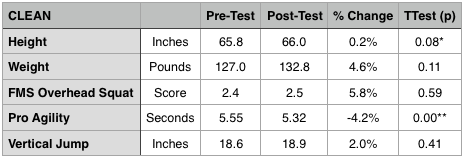
The Snatch group experienced more improvements than the Clean group in all three measures. And all performance improvements were statistically significant. Table 5 shows the Snatch group results.
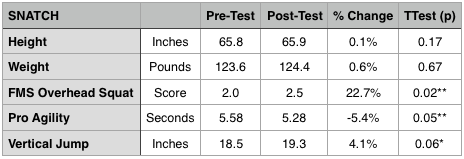
Comparing the results side-by-side you can clearly see the differences between the two groups – Table 6 and Graph 1.
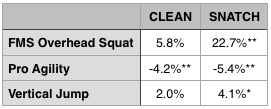
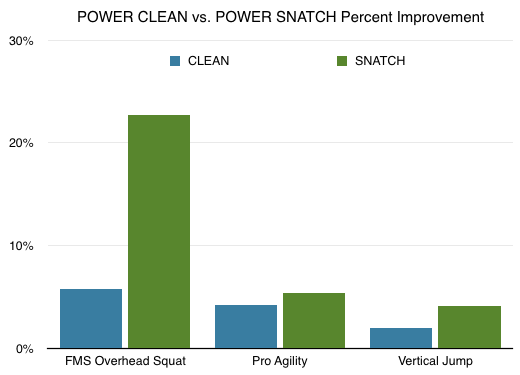
Limitations
Unfortunately, there were a few inherent limitations with our study design. The first limiting factor was our chosen population – young, untrained individuals. The fact that our subjects were all young novices meant that nearly any type of training would have likely produced measurable gains. So, it came as little surprise that we saw improvements in both groups. However, since one group did significantly outperform the other we still believe the results offer some measurable insights.
Second, we did not include a control group in our study design. This was a concession we made in order to keep the academic consistency of the course. The student subjects were enrolled in a graded academic class and were tested on their ability to learn the movements. Therefore we did not feel it was fair or ethical to assign some students to a control group. Obviously, this compromise cost the study scientific consistency. However, we felt that it was in the best interest of the students. There is also a fairly large body of existing research that has already examined OWL and various forms of controlled measures.
Conclusions and Recommendations
First, both the Power Clean and Power Snatch can safely be taught to novice athletes. Based on the methods used in this study, six weeks is sufficient time for previously untrained athletes to learn movement proficiencies which can lead to athletic improvements. Although movement standards for these lifts may not be sufficient for competitive OWL athletes, they are safe and effective.
Second, the Power Clean and Power Snatch can be used to effectively increase athletic performance. Although more difficult to teach and learn, based on the superior improvements our athletes experienced using the Power Snatch, we would recommend it over the Power Clean in cases where an athlete or coach is forced to choose between lifts.
References
- Cissik, J. (1999) Teaching the olympic-style lifts to college students. NSCA strength and conditioning journal, 21 (3), 9-14.
- Faigenbaum, A., Polakowski, C. (1999) Olympic-Style Weightlifting, Kid Style. NSCA strength and conditioning journal, 21 (3), 73-76.
- Chaouachi, A. et al. (2014) Olympic weightlifting and plyometric training with children provides similar or greater performance improvements than traditional resistance training. J Strength and Cond.. 28 (6), 1483-1496.
- Leard, J., et al (2007) Validity of two alternative systems for measuring vertical jump height. J Strength and Cond. 21 (4), 1296-1299.


